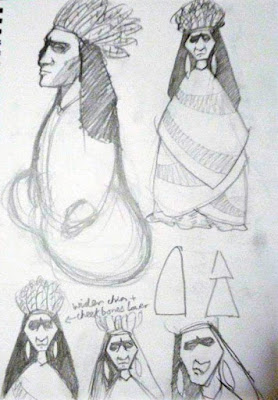Concept Art
I did a concept art painting for the crit session last Tuesday. I did this in order to compile the things that I have researched last week which is the colour palette and the interior design of the teepee. The colour palette for the Shaman works well, but it does not look right when combined with the colour palette I made for Totsi most probably because the colors that I picked for Totsi is too light. Hence, Totsi does not stood out with the intial colour palette. To solve this problem, I decided to apply a bolder blue on her outfit so that the juxtaposition between the Shaman and her is more obvious.
 |
| Concept Painting |
While looking for inspiration for the painting, I browsed through The Art of Big Hero 6 trying to look for a simple style of digital painting. I am intrigued by the paintings done by Victoria Ying because they are clean and simply done in block colours, without smooth blending. She often uses textured brush which gives a nice variation to the painting. I tried to apply these techniques on my painting with a set of brush that I have gotten from a friend.
 |
| Artist Reference: Victoria Ying |
Final models of the characters made by Dan
Working based on our strength has set us an extra time to animate, so that we will have more time to experiment with the movements of the character.
Animatic
As you can see, there are some changes in style. I am not sure whether this is acceptable, but here is my reasoning:
The first drawing style reflects my attempt to compensate the unsatisfying digital concept art painting. colours are useful to establish the scene. I think colour script is rather redundant for a 1 minute long animation, so I decided to stick with the same colour palette in this animation. Instead, I've considered varying the intensity of light emitted by the fire to create suspense in the narrative.
 |
| Coloured |
As soon as I identified what is the important considerations, I put less detail on the animatic, so that I can quickly finish the animatic.
 |
| Monochrome |
Learned that this is the most basic method to draw animatic in the industry as I grew tired of drawing, and look for a faster way to draw the animatic. I watched some animatics from Avatar: The Last Air Bender on YouTube and this is how they do all the animatic throughout an episode.
 |
| Sketchy |




















